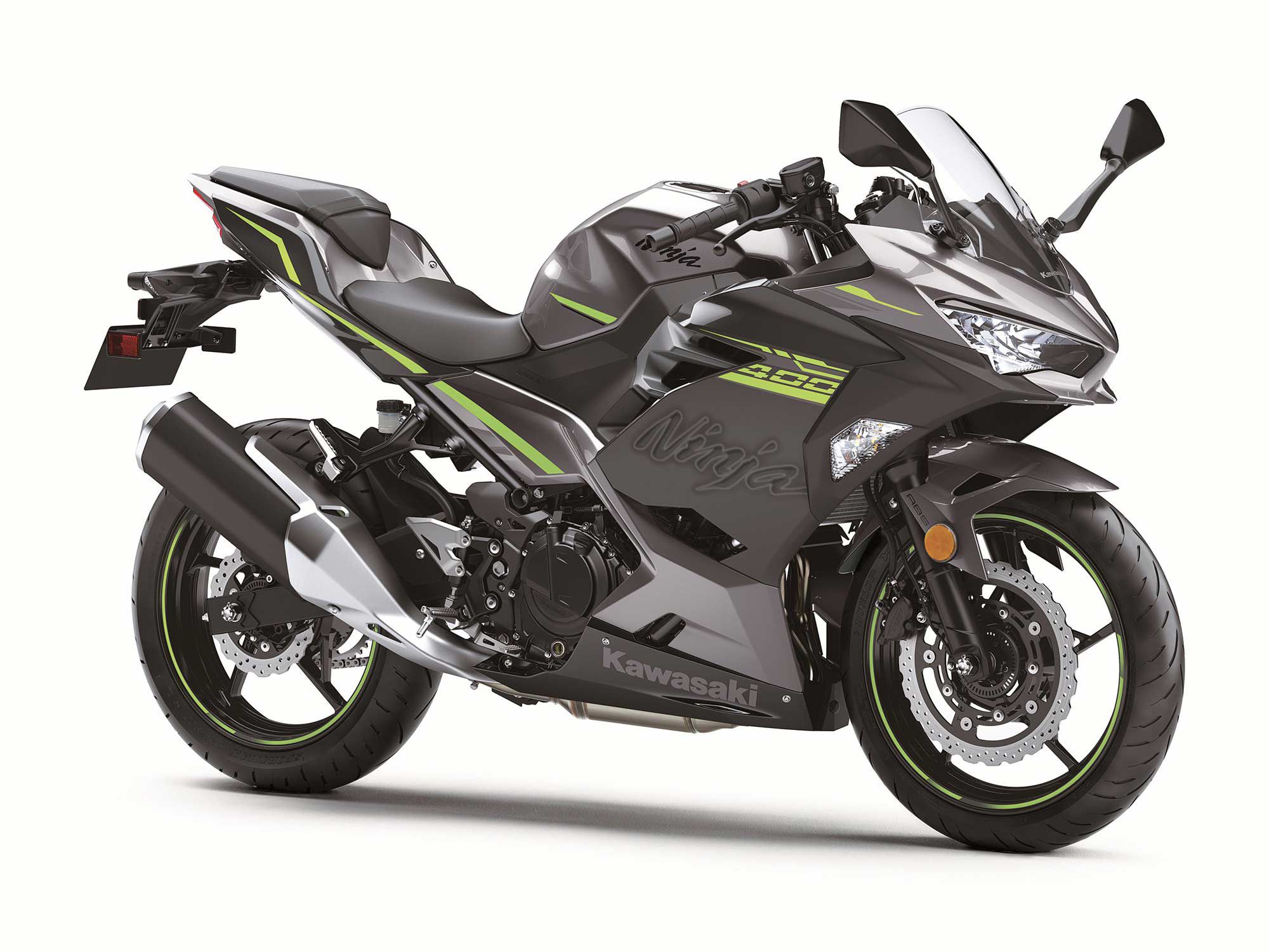
Ups
- Best performance in its class
- Comfy yet sporty ergos
Downs
- Suspension could be a little firmer
- Numb brake feel
Verdict
The Ninja 400 continues to be the go-to bike for serious fun on a tight budget. It’s achieved this mainly through an engine that is just the right size to allow easy control for new riders while still providing enough speed to entertain experts.

Overview
When Kawasaki boosted the previous Ninja 300′s engine displacement by 103cc to help create the Ninja 400 in 2018, the new Ninja quickly vaulted to the front of the entry-level motorcycle category by virtue of its perfectly balanced power/controllability ratio. That balance extends to the rest of the Ninja 400′s performance as well; the riding position is sporty without becoming a torture rack after 20 minutes, the fairing offers good wind protection on the highway as well as the canyons, and the overall chassis feel is comfortable on the street without coming unwound whenever the pace picks up.
Updates for 2021
There are no updates to the 2021 Kawasaki Ninja 400 other than new colorways, which are Pearl Nightshade Teal/Metallic Spark Black, Passion Red, and Metallic Graphite Gray/Metallic Magnetic Dark Gray.
Pricing and Variants
The 2021 Kawasaki Ninja 400 is available in non-ABS models ranging from $4,999 to $5,199 depending on colorway chosen, and ABS models ranging from $5,399 to $5,599 depending on the chosen color scheme.
Competition
Competition for the Kawasaki Ninja 400 includes the fully faired Honda CBR300R, KTM RC 390, Suzuki GSX250R, and Yamaha YZF-R3. Others include Yamaha MT-03, Honda CBR300, plus the more expensive KTM 390 Duke and Husqvarna Vitpilen 401. Even Kawasaki’s own Z400 ABS could be in the mix; here’s a CW comparison between the 2019 Z400 ABS and the Ninja 400 ABS.
Powertrain: Engine, Transmission, and Performance
The 399cc DOHC parallel-twin engine in the Ninja 400 is a complete redesign from the previous Ninja 300 engine, providing a substantial increase in low-end and midrange power. “Rolling on the Ninja’s throttle produces immediate power above 7,500 rpm, pulling stronger out of slow corners,” CW’s Michael Gilbert said in this comparison test, adding that even experienced testers say the Kawasaki “has all the power needed to never let the entertainment wear off.” Strapped to the CW dyno, a 2018 model pumped out 43.4 hp at 9,900 rpm and 24.6 pound-feet of torque at 8,250 rpm. A lightweight power slipper/assist clutch eases clutch pull effort while helping reduce wheel chatter during downshifts.

Handling
The Ninja 400′s high-tensile-steel tube trellis frame and revised suspension are a vast improvement over its 300 predecessor, providing excellent handling manners in the city and the canyons. Aiding these endeavors are the Dunlop GPR-300 tires that offer very good grip and steering characteristics. Only when really pushed hard at a trackday will you find the Kawasaki’s handling start to come a bit unglued, but the vast majority of owners won’t care.
Brakes
The Ninja 400′s Nissin two-piston slide-pin caliper and 310mm disc up front provide adequate stopping power, but the feel is mushy and numb when used aggressively.
Fuel Economy and Real-World MPG
A 2019 Ninja 400 achieved 43.6 mpg during this CW comparison test.
Ergonomics: Comfort and Utility
The Ninja 400 may look like a supersport machine, but the riding position is actually quite relaxed and fairly comfy. There’s more legroom than nearly all of the Kawasaki’s competition in its class, and the fairing provides good wind protection.

Electronics
There are no electronic rider aids (save for antilock brakes on the ABS version) or ride-by-wire throttle wizardry to complicate things for the Ninja 400 rider. Even the dashboard has an old-school round analog tachometer.
Warranty and Maintenance Coverage
The Ninja 400 comes with Kawasaki’s usual 12-month limited warranty. Extended warranty options are available for 12, 24, 36, and 48 months.
Quality
Kawasaki has definitely upped its quality game in the past decade, and the Ninja 400 is no exception. Fit and finish with the Kawasaki is excellent, especially for an entry-level machine.

2021 Kawasaki Ninja 400 Claimed Specifications
| MSRP: | $4,999–$5,199 (depending on colorway)/$5,399–$5,599 (ABS version, depending on colorway) |
| Engine: | 399cc, DOHC, liquid-cooled parallel twin; 8 valves |
| Bore x Stroke: | 70.0 x 51.8mm |
| Transmission/Final Drive: | 6-speed/chain |
| Fuel Delivery: | Electronic fuel injection w/ 32mm throttle bodies |
| Clutch: | Wet, slipper/assist type; cable operation |
| Engine Management/Ignition: | TCBI w/ digital advance |
| Frame: | Steel-tube trellis chassis |
| Front Suspension: | 41mm Showa conventional fork, nonadjustable; 4.7 in. travel |
| Rear Suspension: | Showa shock, spring preload adjustable; 5.1 in. travel |
| Front Brake: | 2-piston sliding-pin caliper, 310mm disc (ABS w/ ABS version) |
| Rear Brake: | 1-piston sliding-pin caliper, 220mm disc (ABS w/ ABS version) |
| Wheels, Front/Rear: | Cast aluminum; 17 x 2.75 in. / 17 x 4.50 in. |
| Tires, Front/Rear: | 110/70-17 / 150/60-17 |
| Rake/Trail: | 24.7°/3.6 in. |
| Wheelbase: | 53.9 in. |
| Ground Clearance: | 5.5 in. |
| Seat Height: | 30.9 in. |
| Fuel Capacity: | 3.7 gal. |
| Wet Weight: | 368 lb. |
| Contact: | kawasaki.com |
Cycle World Tested Specifications
| Seat Height: | 30.9 in. |
| Wet Weight: | 371 lb. |
| Rear-Wheel Horsepower: | 43.4 hp @ 9,900 rpm |
| Rear-Wheel Torque: | 24.7 lb.-ft. @ 8,300 rpm |
| 0–60 mph: | 4.63 sec. |
| 1/4-mile: | 13.19 sec. @ 102.50 mph |
| Braking 30–0 mph: | 35.3 ft. |
| Braking 60–0 mph: | 134.6 ft. |
Source: MotorCyclistOnline.com
